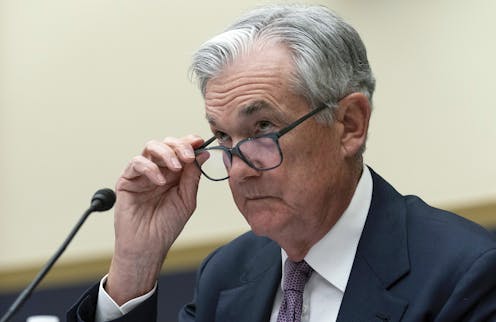Inflation is proving particularly stubborn -- but jitters over banking failures, softening economy complicate Fed rate decision
- Written by Christopher Decker, Professor of Economics, University of Nebraska Omaha

The Federal Reserve is facing a rather sticky problem. Despite its best efforts over the past year, inflation is stubbornly refusing to head south with any urgency to a target of 2%[1].
Rather, the inflation report released on March 14, 2023, shows consumer prices rose 0.4% in February[2], meaning the year-over-year increase is now at 6% – which is only a little lower than in January[3].
So, what do you do if you are a member of the rate-setting Federal Open Market Committee[4] meeting March 21-22 to set the U.S. economy’s interest rates?
The inclination based on the Consumer Price Index data alone may be to go for broke and aggressively raise rates in a bid to tame the inflationary beast. But while the inflation report may be the last major data release before the rate-setting meeting, it is far from being the only information that central bankers will be chewing over.
And economic news from elsewhere – along with jitters from a market already rather spooked by two recent bank failures – may steady the Fed’s hand. In short, monetary policymakers may opt to go with what the market has already seemingly factored in[5]: an increase of 0.25-0.5 percentage point.
Here’s why.
While it is true that inflation is proving remarkably stubborn – and a robust March job report may have put further pressure on the Fed – digging into the latest CPI data shows some signs[6] that inflation is beginning to wane.
Energy prices fell 0.6% in February, after increasing 0.2% the month before. This is a good indication that fuel prices are not out of control despite the twin pressures of extreme weather in the U.S. and the ongoing war in Ukraine. Food prices in February continued to climb, by 0.4% – but here, again, there were glimmers of good news in that meat, fish and egg prices had softened.
Although the latest consumer price report isn’t entirely what the Fed would have wanted to read – it does underline just how difficult the battle against inflation is – there doesn’t appear to be enough in it to warrant an aggressive hike in rates. Certainly it might be seen as risky to move to a benchmark higher than what the market has already factored in[7]. So, I think a quarter point increase is the most likely scenario when Fed rate-setters meet later this month – but certainly no more than a half point hike at most.
This is especially true given that there are signs that the U.S. economy is softening. The latest Bureau of Labor Statistics’ Job Openings and Labor Turnover[8] survey indicates that fewer businesses are looking as aggressively for labor as they once were. In addition, there have been some major rounds of layoffs[9] in the tech sector. Housing has also slowed amid rising mortgage rates and falling prices. And then there was the collapse of Silicon Valley Bank and Signature Bank – caused in part[10] by the Fed’s repeated hikes in its base rate.
This all points to “caution” being the watchword when it comes to the next interest rate decision. The market has priced in a moderate increase in the Fed’s benchmark rate; anything too aggressive has the potential to come as a shock and send stock markets tumbling.
References
- ^ target of 2% (www.cnbc.com)
- ^ consumer prices rose 0.4% in February (www.bls.gov)
- ^ only a little lower than in January (fred.stlouisfed.org)
- ^ Federal Open Market Committee (www.federalreserve.gov)
- ^ market has already seemingly factored in (www.reuters.com)
- ^ shows some signs (www.bls.gov)
- ^ market has already factored in (www.reuters.com)
- ^ Job Openings and Labor Turnover (www.bls.gov)
- ^ rounds of layoffs (www.seattletimes.com)
- ^ caused in part (theconversation.com)







